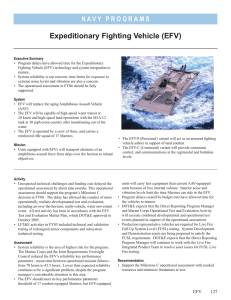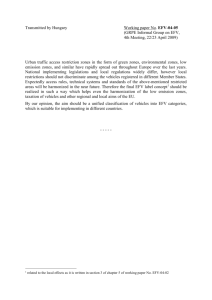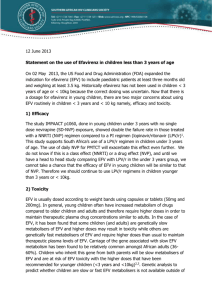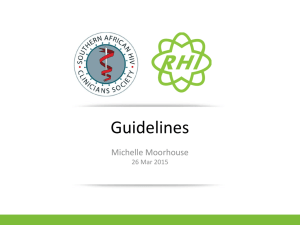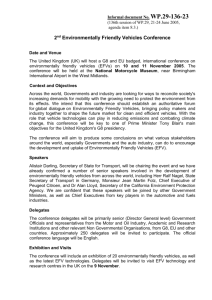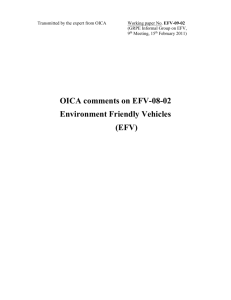Powerpoint
advertisement
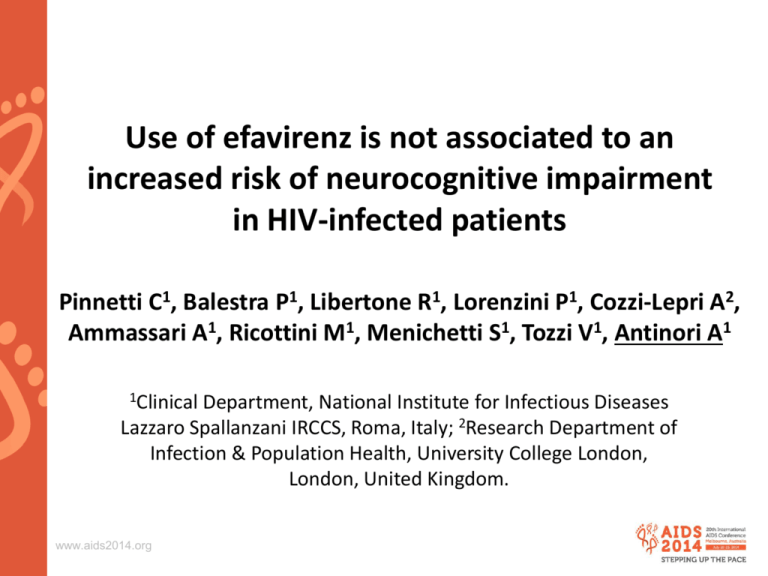
Use of efavirenz is not associated to an increased risk of neurocognitive impairment in HIV-infected patients Pinnetti C1, Balestra P1, Libertone R1, Lorenzini P1, Cozzi-Lepri A2, Ammassari A1, Ricottini M1, Menichetti S1, Tozzi V1, Antinori A1 1Clinical Department, National Institute for Infectious Diseases Lazzaro Spallanzani IRCCS, Roma, Italy; 2Research Department of Infection & Population Health, University College London, London, United Kingdom. www.aids2014.org Disclosures Personal fees for consultancy and lectures from Abbvie, Bristol Myers Squibb, Gilead, Janssen, Merck, ViiV. Travel grants from Abbvie. Research grants from Bristol Myers Squibb, Gilead, Janssen, ViiV. www.aids2014.org Background • Efavirenz (EFV) is currently recommended as a preferred component of ARV regimens for treatment-naïve patients in most of ART guidelines. • Due to patent expiry in 2013, EFV is now available as a generic drug. • EFV has been associated to a well recognized neuropsychiatric side effect pattern1, but an association with neurocognitive impairment (NCI) was not originally confirmed in a randomized trial in ARV naive2. • More recently, EFV has been related to a worse neurocognitive function3-4, but this association remains controversial. 1Mills A, et al. HIV Med 2013;14:391-400; Clifford DB, et al. Ann Intern Med 2005;143:714-721; 3Ciccarelli N, et al. Neurology, 2011;76:1403-1409; 4Letendre S, et al. 20th CROI, Atlanta, GA, 2013; Poster #407. www.aids2014.org Objectives • Aim of the study was: – to evaluate if patients receiving an EFV-based regimen had a worse neurocognitive performance compared to patients currently receiving an ARV regimen not including EFV; – to estimate the risk of NCI independently associated to EFV current use. • The prevalence and severity of HIV-associated neurocognitive disorders (HAND) according to EFV current use was also investigated. www.aids2014.org Methods • Single-centre, retrospective, cross-sectional analysis of cART-treated HIVinfected patients undergoing neuropsychological assessment (NPA). • NPA was carried out by a set of 14 standardized and comprehensive tests on 5 different domains. • People were classified as having NCI if they scored >1 standard deviation (SD) below the normal mean in at least 2 tests, or >2 SD below in 1 test. • As additional binary outcome, HIV-associated neurocognitive disorders (HAND) were classified according to Frascati’s criteria (Neurology, 2007). Clinical depression and other psychiatric disorders has been controlled as confounders. • Z-Scores (neg values if performance was below the mean) were used as continuous outcome: – Global NPZ-8 Deficit Score – Z-Scores for each Cognitive Domain www.aids2014.org NP Battery and Domains • • Concentration and Speed of Mental Processing – Trail Making A – WAIS-R Digit Span (forward) – WAIS-R Digit Span (backward) – WAIS –R Digit Symbol – Stroop Test (word and color) – Corsi's Block-Tapping Test Mental Flexibility – Trail Making B – Stroop test (color and word) – Controlled Oral Association Test www.aids2014.org • • • Memory – Rey Auditory Verbal Learning (immediate recall) – Rey Auditory Verbal Learning (delayed recall) – Rey Complex Figure (delayed recall) Fine Motor Functioning – Lafayette Grooved Pegboard (dominant hand) – Lafayette Grooved Pegboard (non dominant hand) Visuospatial and Constructional Abilities – Rey Complex Figure (copy) Statistical analyses • Comparisons between currently EFV-exposed and currently EFV-not exposed – Mann-Whitney test and Spearman’s Rho for continuous variables – Chi-square test for categorical variables • Univariable and multivariable logistic and linear regression models were fitted. • Variables were retained in multivariable analysis if they had a p-value <0.05. www.aids2014.org Patients characteristics (1020 consecutive NPA over 859 patients) Male gender, n (%) Age, yrs, median (IQR) Mode of HIV transmission, n (%) MSM IVDU heterosexual other/unkown Years of education, median (IQR) CDC C stage, n (%) HCV-Ab positivity, n (%) Nadir CD4 cell/mm3, median (IQR) Current CD4 cell/mm3, median (IQR) HIV-RNA cp/mL at NPA, n (%) undetectable detectable <40 >=40 Haemoglobin <=12 mg/dL, n (%) Calendar year of NPA 2000-2004 2005-2009 2010-2013 www.aids2014.org overall 795 (77.9%) 46 (40-53) EFV (n=324) 265 (81.8%) 46 (40-53) no EFV (n=696) 530 (76.1%) 46 (39-54) 400 (39.2%) 182 (17.8%) 393 (38.5%) 45 (4.4%) 13 (8-13) 245 (24.0%) 285 (27.9%) 190 (82-300) 483 (287-689) 154 (47.5) 44 (13.6) 112 (34.6) 14 (4.3) 13 (8-17) 55 (17.0) 64 (19.7) 225 (112-323) 532 (354-714) 246 (35.3) 138 (19.8) 281 (40.4) 31 (4.4) 13 (8-13) 190 (27.3) 221 (31.8) 165 (73-282) 470 (261-671) 279 (27.5%) 423 (41.6%) 314 (30.9%) 99 (9.7%) 120 (37.1%) 133 (41.2%) 70 (21.7%) 22 (6.8%) 159 (22.9%) 290 (41.8%%) 244 (35.2%) 77 (11.1%) 256 (26.0%) 338 (33.1%) 417 (40.9%) 80 (24.7%) 86 (26.5%) 158 (48.8%) 185 (26.6%) 252 (36.2%) 259 (37.2%) p 0.043 0.874 0.002 <0.001 <0.001 <0.001 <0.001 <0.001 <0.001 0.023 0.001 NCI impairment by EFV current use (NPZ-8) 0 -2 NPZ 8 score 0 -1 -4 -2 NPZ 8 score 1 2 2 NPZ-8 by months of drug exposure for EFV current regimen -3 Spearman's rho=-0.029; P=0.525 EFV -6 No EFV P=0.291 at univariable analysis (Mann-Whitney test) Difference in slope for NPZ-8 from fitting multivariable linear regression models for patients receiving EFV vs those not receiving the drug [Beta -0.04 (95%CI -0.18; 0.09) p=0.514] www.aids2014.org 0 20 40 60 80 Months of exposure to EFV containing regimen Median (IQR) exposure to current EFV regimen: 30 months (12-40). 100 EFV current use and NCI risk (Unadjusted and adjusted risk by logistic regression) Unadjusted Impaired* (n=382) Not impaired* (n=638) On EFV (n=324) 104 (32.1%) 220 (67.9%) Not on EFV (n=696) 278 (39.9%) 418 (60.1%) Impaired* (n=322) Not impaired* (n=537) On EFV^ (n=292) 89 (30.5%) 203 (69.5%) Not on EFV^ (n=567) 233 (41.1%) Adjusted§ OR# 95%CI p OR# 95%CI p 0.71 0.54-0.94 0.016 1.02 0.74-1.41 0.89 0.65 0.46-0.85 0.002 0.98 0.67-1.41 0.90 334 (58.9%) * Subjects are defined as neurocognitivelly impaired if they scored >1 standard deviation (SD) below the normal mean in at least 2 tests, or >2 SD below in 1 test. ^ Sensitivity analysis including only the 859 subjects at the first NP assessment. # Risk of neurocognitive impairment for EFV current use. § Adjusted for age, mode of HIV transmission, years of education, CDC C stage, HCV-Ab positivity, nadir CD4, HIV-RNA and CD4 at NPA, haemoglobin and BMI at NPA, NRTI combination in the current regimen, calendar year of NPA) Older age, IVDU, HCV-Ab+, CDC-C stage, were related to an increased risk of NCI; current CD4 >500 and years of schooling to a decreased risk. www.aids2014.org Gender, CD4 nadir, HIV-RNA undetectable at NPA, anemia, BMI and CPE 2010 not associated. Factors likely to have confounded the association (crude and adjusted OR of NCI by EFV exposure) Current EFV use was associated with a significantly decreased risk of NCI at univariable analysis (OR: 0.71 vs. no EFV; 95%CI 0.54-0.94), but no longer significant after controlling for potential confounding (OR: 1.02; 95%CI 0.74-1.41). 0.95 1.0 1.02 0.71 0.1 crude OR www.aids2014.org OR adjusted for yrs of schooling and for nadir<200 cell/mmc OR adjusted in fully model* EFV current exposure and HAND occurrence Not impaired ANI MND/HAD On EFV (n=324) 220 (67.9%) 51 (15.7%) 53 (16.4%) Not on EFV (n=696) 418 (60.1%) 116 (16.7%) 162 (23.2%) Overall population (n=1020) 638 (62.5%) 167 (16.4%) 215 (21.1%) p 0.026* *EFV-exposed individuals had a significant lower risk to have a symptomatic HAND (MND/HAD) by univariate analysis. www.aids2014.org Beta and 95%CI of Z-score for cognitive areas from fitting multivariable linear regression models for patients receiving EFV vs those not receiving the drug 0.3 0.2 0.1 0.0 0.02; p=0.729 0.03; p=0.541 -0.09; p=0.358 -0.1 -0.12; p=0.315 -0.2 -0.3 -0.4 concentration and mental speed mental flexibility memory fine motor functioning Fully models were adjusted for gender, age, years of education, mode of HIV transmission, CDC-C stage, HCVAb positivity, nadir CD4, CD4 cell count/mmc and HIV-RNA cp/mL at NPA, haemoglobine value, BMI, NRTI backbone in the current regimen. www.aids2014.org Limitations • Observational nature of design – channeling bias (if EFV preferably allocated in individuals at lowrisk of developing NCI); – unmeasured confounders (e.g. drug adherence). • Cross-sectional analysis – reverse causality (if EFV was avoided in patients with NCI); – not considered the effects of previous regimens exposures. • Major depression controlled as a confounder, but a systematical assessment of depression (e.g. BDI-II, PHQ-9 or CES-D) was not performed in all subjects. www.aids2014.org Conclusions • In this large case series, EFV exposure was not associated with an increased risk of NCI. • Current EFV use was associated with a 30% decreased risk of NCI at univariable analysis, but no longer significant after controlling for schooling and other potential confounding. • In subjects receiving EFV, no increased risk of HAND occurred. • The duration of EFV exposure was not related to worse neurocognitive performance. • No increased risk of impairment according to specific domains was observed in EFV-exposed. • Even though confounding by indication may play a role, and reverse causality cannot be ruled out, our results suggest that presence of NCI among persons treated with EFV-based cART is not more common than in people not treated with EFV www.aids2014.org
